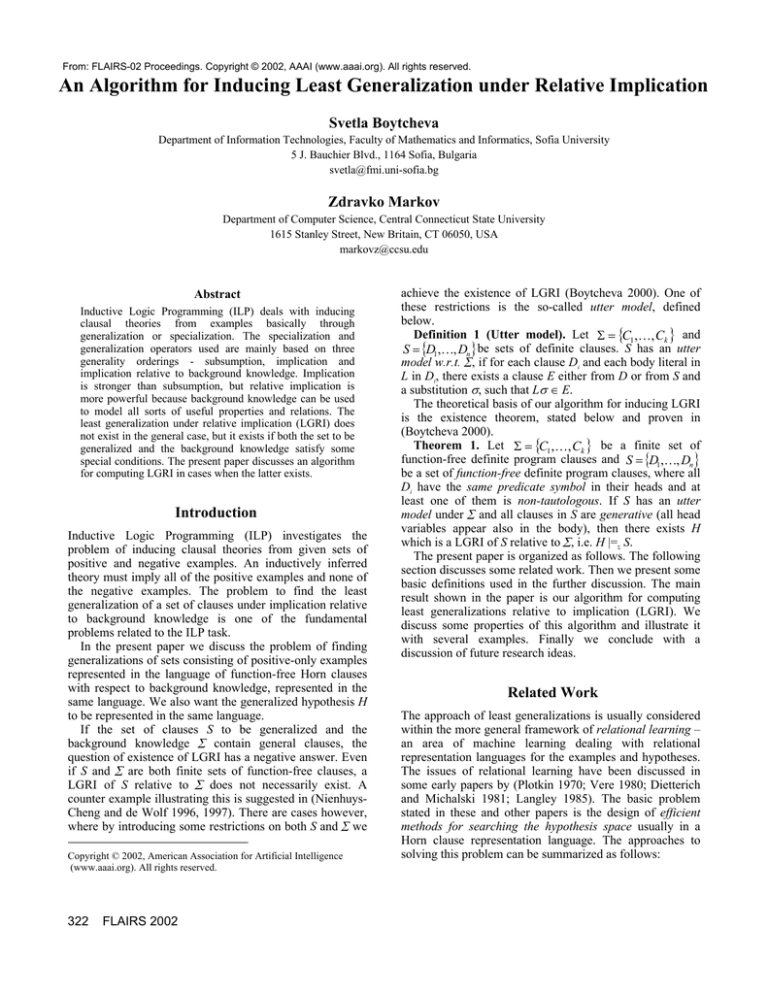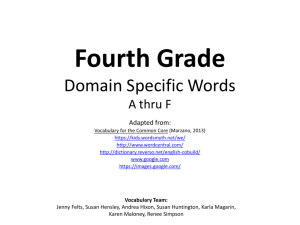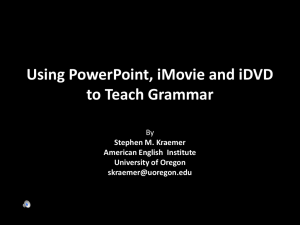
From: FLAIRS-02 Proceedings. Copyright © 2002, AAAI (www.aaai.org). All rights reserved.
An Algorithm for Inducing Least Generalization under Relative Implication
Svetla Boytcheva
Department of Information Technologies, Faculty of Mathematics and Informatics, Sofia University
5 J. Bauchier Blvd., 1164 Sofia, Bulgaria
svetla@fmi.uni-sofia.bg
Zdravko Markov
Department of Computer Science, Central Connecticut State University
1615 Stanley Street, New Britain, CT 06050, USA
markovz@ccsu.edu
Abstract
Inductive Logic Programming (ILP) deals with inducing
clausal theories from examples basically through
generalization or specialization. The specialization and
generalization operators used are mainly based on three
generality orderings - subsumption, implication and
implication relative to background knowledge. Implication
is stronger than subsumption, but relative implication is
more powerful because background knowledge can be used
to model all sorts of useful properties and relations. The
least generalization under relative implication (LGRI) does
not exist in the general case, but it exists if both the set to be
generalized and the background knowledge satisfy some
special conditions. The present paper discusses an algorithm
for computing LGRI in cases when the latter exists.
Introduction
Inductive Logic Programming (ILP) investigates the
problem of inducing clausal theories from given sets of
positive and negative examples. An inductively inferred
theory must imply all of the positive examples and none of
the negative examples. The problem to find the least
generalization of a set of clauses under implication relative
to background knowledge is one of the fundamental
problems related to the ILP task.
In the present paper we discuss the problem of finding
generalizations of sets consisting of positive-only examples
represented in the language of function-free Horn clauses
with respect to background knowledge, represented in the
same language. We also want the generalized hypothesis H
to be represented in the same language.
If the set of clauses S to be generalized and the
contain general clauses, the
background knowledge
question of existence of LGRI has a negative answer. Even
if S and are both finite sets of function-free clauses, a
does not necessarily exist. A
LGRI of S relative to
counter example illustrating this is suggested in (NienhuysCheng and de Wolf 1996, 1997). There are cases however,
where by introducing some restrictions on both S and we
Copyright © 2002, American Association for Artificial Intelligence
(www.aaai.org). All rights reserved.
322
FLAIRS 2002
achieve the existence of LGRI (Boytcheva 2000). One of
these restrictions is the so-called utter model, defined
below.
Definition 1 (Utter model). Let Σ = {C1 ,K, Ck } and
S = {D1,K, Dn } be sets of definite clauses. S has an utter
PRGHOZUW , if for each clause D and each body literal in
i
L in Di, there exists a clause E either from D or from S and
a substitution σ, such that Lσ ∈ E.
The theoretical basis of our algorithm for inducing LGRI
is the existence theorem, stated below and proven in
(Boytcheva 2000).
Theorem 1. Let Σ = {C1 ,K, Ck } be a finite set of
function-free definite program clauses and S = {D1,K, Dn }
be a set of function-free definite program clauses, where all
Di have the same predicate symbol in their heads and at
least one of them is non-tautologous. If S has an utter
model under and all clauses in S are generative (all head
variables appear also in the body), then there exists H
which is a LGRI of S relative to , i.e. H |= S.
The present paper is organized as follows. The following
section discusses some related work. Then we present some
basic definitions used in the further discussion. The main
result shown in the paper is our algorithm for computing
least generalizations relative to implication (LGRI). We
discuss some properties of this algorithm and illustrate it
with several examples. Finally we conclude with a
discussion of future research ideas.
Related Work
The approach of least generalizations is usually considered
within the more general framework of relational learning –
an area of machine learning dealing with relational
representation languages for the examples and hypotheses.
The issues of relational learning have been discussed in
some early papers by (Plotkin 1970; Vere 1980; Dietterich
and Michalski 1981; Langley 1985). The basic problem
stated in these and other papers is the design of efficient
methods for searching the hypothesis space usually in a
Horn clause representation language. The approaches to
solving this problem can be summarized as follows:
•
•
•
•
•
Using higher-order rule schemas to constrain
search. This is the approach taken in MODELER
(Wrobel 1988) and its extensions CIA (De Raedt
and Bruynooghe, 1989a, 1989b) and RDT (Kietz
and Wrobel, 1991).
Using search heuristics based on information gain
–an approach, taken in FOIL (Quinlan 1990) and
its extensions CHAM (Kijsirikul, Numao and
Shimura 1991), FOCL (Pazzani and Kibler 1990)
and STRUCT (Watanabe and Rendell 1991).
Constraining search by inducing refutation trees
with inverse resolution operators. The approach is
used in systems as MARVIN (Muggleton and
Buntine 1988), RINCON (Wogulis and Langley
1989; Wogulis 1989), CIGOL (Muggleton and
Buntine 1988), IRES (Rouveirol and Puget 1990)
and SIERES (Wirth and O'Rorke 1991).
Using propositional or other representations to
simplify the search space. Basic instances of this
approach are LINUS (/DYUDþ ']HURVNL DQG
Grobelnik 1991) and Wy1 (Flann and Dietterich
1986).
Avoiding general search by constructing relative
least general generalizations. This is the approach
taken in GOLEM (Muggleton and Feng 1990).
Our approach falls in the same category.
As generally the relational languages are complex and
consequently the search space is usually huge, some
approaches reduce the relational language to propositional
representations, while others try to impose constraints on
the relational representation. The latter approaches are
more promising, because they preserve the expressive
power of the relational languages.
Various restrictions have been suggested to simplify the
search in the relational hypothesis space. In many of the
approaches the background knowledge consists only of
ground literals clauses. Our approach however departs from
these strong restrictions. The algorithm we introduce
hereafter can work with function-free non-recursive Horn
clauses without negation. The algorithm also exhibits a
kind of a predicate invention feature - if necessary it
generates new-predicate description to extend the
background knowledge.
Preliminaries
In this section we give a theorem and a basic definition
from (Lloyd 1984), both needed in the discussion of the
algorithm in the next section.
Theorem 2 (Unification theorem). Let S be a finite set
of first order expressions. If S is unifiable, then the
unification algorithm terminates and gives an mgu for S. If
S is not unifiable, then the unification algorithm terminates
and reports this fact.
Definition 2 (Disagreement set). Let S be a finite set of
first order expressions. The disagreement set of S is defined
as follows. Locate the leftmost symbol position at which
not all expressions in S have the same symbol and extract
from each expression in S the sub-expression beginning at
this symbol position. The set of all such sub-expressions is
the disagreement set.
Algorithm for Inducing LGRI
Let S = {D1 ,K, Dn } be a finite set of function-free Horn
clauses with identical head literals Head, i.e. Di=Head:Bodyi. Let Σ = {C1 , K, C k } be a finite set of function-free
satisfy the requirements of
Horn clauses. Let S and
Theorem 1. Then, there exists H, a LGRI of S relative to ,
where the clauses in H have the head literal Head.
Algorithm
1.
2.
Using the unification algorithm find the common
literals in the bodies of clauses from S and create a set
Common.
Using the unification algorithm find the disagreement
set of S and create set S’={Fi | Fi=Bodyi\&RPPRQ i,
i=1,…,n}, where Common is the set from step 1, Bodyi
is the body of the clause Di ∈ S and i is the most
general unifier of Common and Bodyi.
3.
4.
If S' is empty then go to step 11 else continue.
Using and S' create a set R containing all resolvents
of clauses from S' and . This set is finite, because all
clauses are non-recursive and function-free, and S and
are finite sets.
5.
If R is empty then go to step 9 else continue.
6.
Replace each Fi ∈ S' (or a part of it) with its
corresponding resolvent Rij from R.
7.
Create a set R', where:
R'={Rij | Rij ∈ R, ∃Fi ∈ S', ∃Gi ⊆ Fi, ∃σi, Rij= Giσi }
8. Use the unification algorithm to create a set RCommon
containing the common literals in the clauses from R'.
9. Create a set S'' = S' \ RCommon and separate the
literals in the clauses of S'' in groups with independent
variables. Identify a subset of literals Ei in each group,
such that, its variables when substituted by the most
general unifier, map onto a common set of variables V
for all clauses in S''. Find all such sets (if exist).
10. For each non-empty set V use its variables as head
variables and generate a new clause New(V) :- Ei with
new predicate symbol New and go to step 12.
11. Return H = Head :- Common. END
12. Return H = {H ,…,Hm}, where
1
Hi = Head :- Common, RCommon, Newi.
(Newi (i = 1,…,m) are the heads of the predicates
generated in step 10.) END
FLAIRS 2002
323
Annotated Example
For better understanding we illustrate the steps of the
algorithm with an example. Consider the following two
DCG rules, represented as Prolog clauses:
S = {sentence(X) :- append(L1,L2,X), append(D,N,L1),
det(D), noun(N), verb(L2);
sentence(X) :- append(L1,L2,X), proper_name(L1),
verb(L2) }
= {}
Before starting the algorithm we need to rename the
variables in the two clauses. This is a standard procedure
required for the application of the resolution rule. Thus we
get:
S={
sentence(X1) :- append(L11,L21,X1),append(D1,N1,L11),
det(D1), noun(N1), verb(L21);
sentence(X2) :- append(L12,L22,X2), proper_name(L12),
verb(L22) }
Step 1. First, we antiunify the two heads in S and determine
the head literal of the hypothesis sentence(A) along with the
substitutions {A/X1} and {A/X2}. Then we find the set
Common = {append(B,C,A), verb(C)} and the substitutions
= {A/X1, B/L11, C/L21} and 2 = {A/X2, B/L12,
1
C/L22}.
Step 2. We compute the disagreement set S’ = {F1, F2},
where F1 = append(D1,N1,B), det(D1), noun(N1) and F2 =
proper_name(B).
Step 3. S’ is not empty, so we try step 4.
Obviously the meaning of the new predicate is the
definition of the noun phrase rule, so we can rename it
accordingly as:
noun_phrase(B) :- append(D1,N1,B), det(D1), noun(N1).
noun_phrase (B) :- proper_name(B).
Correctness
Hereafter we shall prove the correctness of the algorithm.
Firstly, we have to show that H is a generalization of S
relative to , i.e. H |= S. In fact, we have to prove that
H U Σ |= S or H U Σ |=Di for every Di. Let H =
{H1,…,Hm}, where Hi is constructed by the algorithm as
follows: Hi = Head :- Common, RCommon, Newi. Also,
according to the construction method of Common and Fi, it
is clear that Bodyi = Common, Fi. That is Di = Head :Common, Fi. For each Fi we have its resolvent with in
RCommon, which in turn is a part of H. In this way we
have H U Σ U ¬{Di } |= WKDWLV H U Σ |= Di.
Showing that H is a least generalization of S relative to
is needs more space and due to the lack of the latter we
omit this proof here.
Applications
The algorithm can be used as an incremental algorithm for
supervised learning where the teacher chooses a particular
sequence of clauses from S and feeds them one at a time
into the algorithm to be generalized (Figure 1). Another
scenario is shown in Figure 2, where the algorithm
generalizes a set of clauses directly.
The algorithm is also applicable to a situation without
background knowledge, i.e. ø. In this case it finds the
least general generalization under implication of a set of
clauses.
H
is empty we cannot create any
Steps 4, 5. Since
resolvents. Thus R is also empty and we continue with step
9.
Step 9. Since RCommon is empty, S’’ = S’. Both F1 and F2
have one group of dependent variables (no groups with
mutually independent variables). These groups are {D1,
N1,B} and {B}. Obviously, the set of common variables V
is {B}. The corresponding sets of literals are E1 =
{append(D1,N1,B), det(D1), noun(N1)} and E2 =
{proper_name(B)}.
H2
H1
D1
D3
D2
…
Dn
Fig. 1: Incremental construction of hypothesis.
Step 10. Here we create the new predicate
H
new(B) :- append(D1,N1,B), det(D1), noun(N1).
new(B) :- proper_name(B).
and continue with step 12.
Step 12. Return the LGRI of S relative to :
H = sentence(A) :- append(B,C,A), verb(C), new(B).
324
FLAIRS 2002
D1
D2
D3
…
Dn
Fig. 2: Construction of a hypothesis from a set of clauses.
the algorithm infers
More Examples
In this section we further illustrate the algorithm introduced
in the previous section with more examples.
Example 1
Given
S = {grandparent(X,Z) :- man(X),parent(X,Y),parent(Y,Z);
grandparent(X,Z) :- parent(X,Y),man(Y),parent(Y,Z)}
={}
the algorithm generates the hypothesis
H = grandparent(X,Z) :- parent(X,Y), parent(Y,Z).
The set Common here is {parent(X,Y), parent(Y,Z)}. As
no common set of variables can be found in the
disagreement set S’= {F1 = man(X), F2 = man(Y)}, no new
predicates are generated and the final hypothesis contains
the set Common only.
The generalization in this example is equivalent to the
one produced under the subsumption generality ordering,
because H is a subset of each one of the two clauses in S.
Example 2
In this example we illustrate how the algorithm handles
background knowledge. Given
S = {cuddlypet(X) :- small(X), fluffy(X), dog(X);
cuddlypet(X) :- fluffy(X), cat(X)},
= {pet(X):-cat(X); pet(X):-dog(X); small(X):-cat(X)},
the algorithm infers
H = cuddlypet(X) :- fluffy(X), small(X), pet(X).
During this inference three other sets of clauses are
generated:
Common = {fluffy(X)}
S’ = {:-small(X),dog(X); :- cat(X)}
R = RCommon = {:-small(X), :-pet(X)}
H = {employer(X) :- nationality(X), good_skills(X,Y) }.
It also generates two clauses with new predicate symbols,
which we replace for clarity with “good_skills”:
good_skills(X,Y) :- educated(X,Y), good_reputation(Y).
good_skills(X,Y) :- recommendation(X,Y),
previous_employer(X,Y).
Conclusion and Further Work
The presented algorithm is a step towards investigating the
potential of constructive generalization with respect to
background knowledge in the context of Inductive Logic
Programming. The problem of using logical implication in
a constructive way is known to be hard. This especially
applies to the computational complexity of the
generalization operators. Our algorithm is based on two
other algorithms, which are very well studied with respect
to their complexity. These are the unification algorithm and
the resolution procedure. In our experimental
implementation of the algorithm we use Prolog, a language
in which these algorithms are built-in. Thus the examples
we discussed in the paper, as well as more complex
examples run relatively quickly. Nevertheless we have to
further investigate the computational complexity of our
algorithm, because it uses unification and resolution in a
specific way and under some restrictions that may allow to
improve the algorithm overall efficiency.
Another direction for future research is extending the
representation language to clauses with negation and/or
recursive clauses. Also we will continue our theoretical
investigations on other possible cases of existence of LGRI,
especially for sets of general (non function-free) clauses.
References
Boytcheva, S. 2000. Least Generalization under Relative
Implication. In Proceedings of the Ninth International
Conference Artificial Intelligence: Methodology, Systems
and Applications, 59-68. LNAI 1904: Springer-Verlag
This example illustrates the most general situation. Given a
set of clauses S and background knowledge :
De Raedt, L., & Bruynooghe, M. 1989a. Constructive
induction by analogy. InProceedings of the Sixth
International Workshop on Machine Learning , 476-477.
Ithaca, NY: Morgan Kaufmann.
S = {employer(X) :- english(X), educated(X,Y),
good_reputation(Y);
employer(X) :- french(X), recommendation(X,Y),
previous_employer(X,Y)}
De Raedt, L., & Bruynooghe, M. 1989b. Constructive
induction by analogy: A method to learn how to learn? In
Proceedings of the Fourth European Working Session on
Learning, 189-200. Montpellier, France: Pitman.
Example 3
= {nationality(X) :- english(X);
nationality(X) :- french(X)}.
Flann, N. S., & Dietterich, T. G. 1986. Selecting
appropriate representations for learning from examples. In
Proceedings of the Fifth National Conference on Artificial
FLAIRS 2002
325
Intelligence,
Kaufmann.
460-466.
Philadelphia,
PA:
Morgan
Kietz, J-U., & Wrobel, S. 1991. Controlling the complexity
of learning in logic through syntactic and task-oriented
models. In Proceedings of the First International Workshop
on Inductive Logic Programming , 107-126. Vienna de
Castelo, Portugal: Unpublished.
Kijsirikul, B., Numao, M., & Shimura, M. 1991. Efficient
learning of logic programs with non-determinate, nondiscriminating literals. In Proceedings of the First
International Workshop on Inductive Logic Programming
33-40. Vienna de Castelo, Portugal: Unpublished.
Van der Laag, P. 1995. An analyses of refinement
operators in inductive logic programming, Ph.D thesis,
Tinberg Institute Research Series, Rotherdam.
Lloyd, J.W. 1984. Foundations of Logic Programming,
Springer-Verlag Berlin Heidelberg.
Muggleton, S. and Buntine, W. 1988. Machine invention of
first-order predicates by inverting resolution. In J.Laird
editior, Proceedings of the 5th International Conference on
Machine learning (ICML-88), pages 339-352, Morgan
Kaufman, San Mateo, CA.
Muggleton, S., & Feng, C. 1990. Efficient induction of
logic programs. Proceedings of the First International
Workshop on Algorithmic Learning Theory, 368-381,
Tokyo, Japan: Japanese Society for Artificial Intelligence.
Nienhuys-Cheng, S-H. and de Wolf, R. 1997. Foundations
of Inductive Logic Programming, Springer-Verlag,Berlin
Heidelberg.
Nienhuys-Cheng, S-H. and de Wolf, R. 1996. Least
generalizations and greatest specializations of sets of
clauses, Journal of Artificial Intelligence, 4:341-363.
Dietterich, T. G., & Michalski, R. S. 1981. Inductive
learning of structural descriptions. Artificial Intelligence,
16, 257-294.
Langley, P. 1985. Learning to search: From weak methods
to domain-specific heuristics. Cognitive Science, 9, 217260.
/DYUDþ 1 ']HURVNL 6 *UREHOQLN 0 /HDUQLQJ
non-recursive definitions of relations with LINUS . In
Proceedings of the Fifth European Working Session on
Learning, 265-281. Porto, Portugal: Springer-Verlag.
Pazzani, M., & Kibler, D. 1990. The utility of knowledge
in inductive learning (Technical Report 90-18). University
of California, Irvine, Department of Information and
Computer Science.
326
FLAIRS 2002
Plotkin, G. D. 1970. A note on inductive generalization. In
B. Meltzer & D. Michie (Eds.), Machine Intelligence (Vol.
V). New York, NY: Elsevier North-Holland.
Quinlan, J. R. 1990. Learning logical definitions from
relations. Machine Learning, 5, 239-266.
Rouveirol, C., & Puget, J. F. 1990. Beyond inversion of
resolution. In Proceedings of the Seventh International
Conference on Machine Learning, 122-130. Austin, TX:
Morgan Kaufmann.
Vere, S. A. 1980. Multilevel counterfactuals for
generalizations of relational concepts and productions.
Artificial Intelligence, 14, 139-164.
Wirth, R., & O’Rorke, P. 1991. Inductive completion of
SLD proofs. In Proceedings of the First In-Iternational
Workshop on Inductive Logic Programming, 167-176.
Vienna de Castelo, Portugal:
Wogulis, J. 1989. A framework for improving efficiency
and accuracy. In Proceedings of the Sixth Inter-national
Workshop on Machine Learning (pp. 78{80). Ithaca, NY:
Morgan Kaufmann.
Wogulis, J., & Langley, P. 1989. Improving efficiency by
learning intermediate concepts. In Proceedings of the
Eleventh International Joint Conference on Artificial
Intelligence, 657-662, Detroit, MI: Morgan Kaufmann.
Wrobel, S. 1988. Automatic representation adjustment in
an observational discovery system. In Proceedings of the
Third European Working Session on Learning, 253-262,
Glasgow, Scotland:Pitman.
Watanabe, L., & Rendell, L. 1991. Learning structural
decision trees from examples. In Proceedings of the
Twelfth International Joint Conference on Artificial
Intelligence. Sydney, Australia: Morgan Kaufmann.







